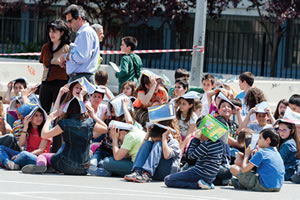Managing Mass Notification
- By Michael Fickes
- 05/01/15

PHOTO © VERVERIDIS VASILIS / SHUTTERSTOCK.COM
Does your school have a mass notification system? Do you know how to use it? Do you know who does know how to use it?
“I’ve visited a number of schools where no one knows how to use the mass note system,” says Paul Timm, president of Lemont, Ill.-based RETA Security, Inc. “Many students, faculty and staff have not been registered in the system, and no one has learned how to use it.
“So the first steps to managing a mass notification system are learning to use it and registering the community.”
It’s not good enough for one person to learn the system, either, continues Timm. A number of people should know how to use it. If someone were absent, a backup operator would have to step in.
Don’t forget nights and weekends. A couple people that are around on nights and weekends should know how send out notifications as well.
Qualified operators will know how to select the appropriate message from prerecorded messages about various emergencies. They will know how to send the messages by text, phone and email.
Each operator must practice using the system to maintain skills, too. Operators that don’t practice risk getting it wrong when an emergency comes.
Don’t practice by sending non-emergency messages over the system. Students and faculty should think that something serious might be happening when they receive an alarm from the mass notification system.
“If you send out too many non-urgent messages, it can be like crying wolf,” says Rick Thompson, a security consultant with RETA. “You can hold drills twice a year. Other than that, don’t use the mass notification system for anything but emergencies.”
Register the community
A survey conducted several years ago found that large percentages of students do not register their phone numbers and email addresses with their mass notification system. So you have to develop a campaign to register as many people as possible.
“Today, students do everything online,” Timm observes. “The way to register students for the mass notification system is to make them register their phones and email addresses in the mass notification system before letting them register for class.”
“You can notify students with the public address system. But if they are away from school when something happens and you don’t want them to come back, you’ll have to use email, text and phone mass notification techniques.”
But in K-12 schools, the most important mass notification registrants are parents, continues Timm. You have to notify parents of any serious problem at the school and provide instructions as to what they should do. Administrators usually want parents to stay away from school in a serious emergency and will message them to gather at a preselected meeting area where school buses will take the students.
Faculty and staff typically register at low percentages, too, Timm notes. He recommends a policy that requires registering with the system before issuing credentials such as access control cards or ID cards. Tie registering to something they cannot do without.
“If you run a district- or school-wide mass notification registration campaign, you will have a side benefit of helping to improve everyone’s security awareness.”
Even when you have registered the community, don’t forget there are alternative communication tools available today: Twitter, other social media, email and your school’s website. Use these tools to supplement your mass notification system communications.
One more point about registration: update the information regularly. “People are always getting new phones and changing phone numbers. You have to update frequently,” says Ron Lander, CPP, CMAS, a principal with Norco, Calif.-based Ultrasafe Security Specialists.
Lander recommends taking a cue from retailers. Best Buy, for instance, checks customer information when customers use their rewards card. The cashier always asks whether the telephone number and address in the store’s records are correct. Make it a point to check contact information with students regularly.
Recorded messages
Security professionals all recommend pre-recording messages. That way, you can think out what instructions you want to deliver, how best to word the message and the tone you want to strike.
During an emergency, you won’t have time to think. Moreover, a mistake during a fire or violent incident could prove deadly.
Recorded messages should cover the incidents involving imminent danger: an active shooter, a fire, weather events and so on. Be sure to add alerts for gas leaks and other kinds of serious maintenance problems.
Develop messages that cover incidents from various points of view. For instance, “a person with a gun seen in front of the building” presents a situation that could develop into a shooting. A message such as “shots fired in front of the school” alerts people to an active shooting event.”
Don’t overdo the messages. “Keep the idea of imminent danger in mind,” says RETA’s Thompson. “Is someone likely to be injured? If so, use the mass notification system. If not, don’t use it.
“Suppose, for instance, there is a report of an unauthorized person in the building. You don’t know if the person is a threat. An adult should investigate, but you shouldn’t use the mass notification system because there is no imminent danger.”
Thompson also recommends considering the geography or context and time. If there is a shooting down the street from a school in Chicago, the community should know about it. On the other hand, if a school is a mile away in a suburban neighborhood, it doesn’t matter.
Finally, there is the element of time. “If a robbery just happened in or around the school, use the mass notification system to put out an alert to students and parents,” Thompson says. “If it happened more than 30 minutes ago, inform the community with email.
In the end, a well-managed, well-drilled mass communication system makes a powerful safety and security tool for a K-12 school.
This article originally appeared in the issue of .